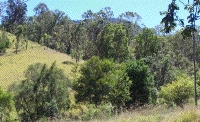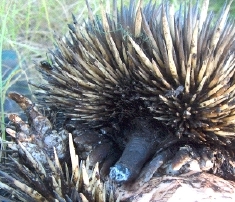 |
|||||||
| Home |
Tours |
Wildlife | Our region | Prices | About Araucaria |
Contact us |
|
Conservation action by the Araucaria team
On the Araucaria property
 Conservation of
native habitats on the Araucaria property:
seasonally-dry rainforest and rainforest regrowth, Eucalyptus tereticornis
with understorey of native grass (mostly Themeda), riparian
forest of sheoaks, melaleuca and others, and the creek
itself
Conservation of
native habitats on the Araucaria property:
seasonally-dry rainforest and rainforest regrowth, Eucalyptus tereticornis
with understorey of native grass (mostly Themeda), riparian
forest of sheoaks, melaleuca and others, and the creek
itself- Restoration of rainforest - fencing off from
horse-grazing, clearing weeds, planting of
locally-native trees and other plants
- Research on animal-plant mutualisms, with
relevance to biodiversity conservation (it's not enough
to preserve a plant species in a reserve - for long term
survival of the species we need to ensure their pollinators
and seed dispersers are protected too, and these
pollinators and dispersers have their own needs, which
may be especially challenging in particular seasons.
- Monitoring of fauna and flora - a standard bird
count in five localities on and adjacent to our property
is undertaken quarterly, live traps for mammals and
other observations of wildlife plus fruiting and
flowering of plants more opportunistically.
We can thus keep alert for changes over the seasons and
years, and attempt to interpret such changes.
- Use of our Scenic Rim
Wildlife Ecology Centre for local group meetings
and education
Elsewhere
-
 Fauna surveys, wildlife
corridor planting, bioblitz, community
education and other conservation projects through
the Scenic
Rim branch of
Wildlife Queensland, of which Ronda is chair
and Darren is treasurer - also discussions on the
Scenic Rim Wildlife Facebook,
and representing the organisation at various
events run by others. Our major project at present is
the establishment
of wildlife corridors in the Scenic Rim. including
surveys to see if wildlife using them and monitor
changes over the years.
Fauna surveys, wildlife
corridor planting, bioblitz, community
education and other conservation projects through
the Scenic
Rim branch of
Wildlife Queensland, of which Ronda is chair
and Darren is treasurer - also discussions on the
Scenic Rim Wildlife Facebook,
and representing the organisation at various
events run by others. Our major project at present is
the establishment
of wildlife corridors in the Scenic Rim. including
surveys to see if wildlife using them and monitor
changes over the years.
- Input into environmental sustainability of
wildlife tourism, especially through Wildlife Tourism
Australia, of which Ronda is chair and Darren
is membership secretary, organising workshops and
conferences, regularly contributing to the website and
the WTA Facebook page
as well as sending newsletters, communicating directly
with members, writing submissions to government etc.
WTA's mission statement is to promote the
sustainable development of a diverse wildlife
tourism industry that supports conservation.
- Ronda and Darren's membership of Protect The Bush Alliance, an alliance of various conservation and natural history organisations aiming to protect fauna and flora from inappropriate development. Ronda was a founding member, and she and Darren set up its Facebook site.
- Active membership of the Lamington Natural History
Association (presentations, guiding interpretive
walks, input to information
 centre)
for many years. Ronda and Darren have both
previously been committee members.
centre)
for many years. Ronda and Darren have both
previously been committee members.
- Ronda's involvement in the Biodiversity Working
Group of TAPAS (Tourism And Protected AreaS)
within IUCN (International Union for Conservation of
Nature)
- Contribution of information on flora and fauna
seen on tour to various databases and to other
researchers
- Research on the interdependence
of
plants and animals - especially fruit-eating
animals that disperse the seeds of native trees, shrubs,
vines and other plants (as above)
- Rescue of injured or orphaned native animals
and transport to vet or carer (e.g. the echidna on the
right, rescued fro the road in the middle of the night
with minor injuries).
- Environmental consultancies, through which we assist with the designation of conservation areas, monitoring and advice on conservation management or minimising of developmental impacts
Tourist involvement in conservation
Our guests can get involved in research and conservation during some of our tours, either briefly during regular tours or on special tours, interspersed with walks, wildlife viewing and interpretive activities.
Research activities guests can choose to get involved in include:

- surveying for wildlife along the corridor routes
(see. above). Guests won't be expected to identify
the animals but can help us find and possible photograph
them.
- helping to find (and where possible photograph) various species elsewhere for various databases, academic researchers and local councils to enhance understanding of their assist development of conservation management plans.
- helping to record seasonal changes (what do
animals eat and where do they need to go in different
seasons) and visitors to flowers and fruits
(some of which may need the animals for pollination or
seed dispersal), which will assist in assessing whether
needs are adequately met in protected areas and habitat
fragments on private or public lands. Guests can take
photos of any interactions of animals and plants to send
us with information on time and place, also keep an eye
out for specific species to alert our attention to
during a tour so we can record their presence and
behavviour.
- helping to collect native seeds and prepare experimental plots for research into the needs of local plants dispersed by birds and other animals
- planting of food-plants and shelter for
wildlife in damxsaged habitat fragments.
- weeding around young native plants
- (for the more energetic on special tours) helping to clear lantana on creek banks where it might impede establishment of platypus burrows and crowd out native plants
- donating to local conservation organisations
